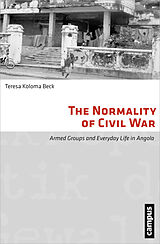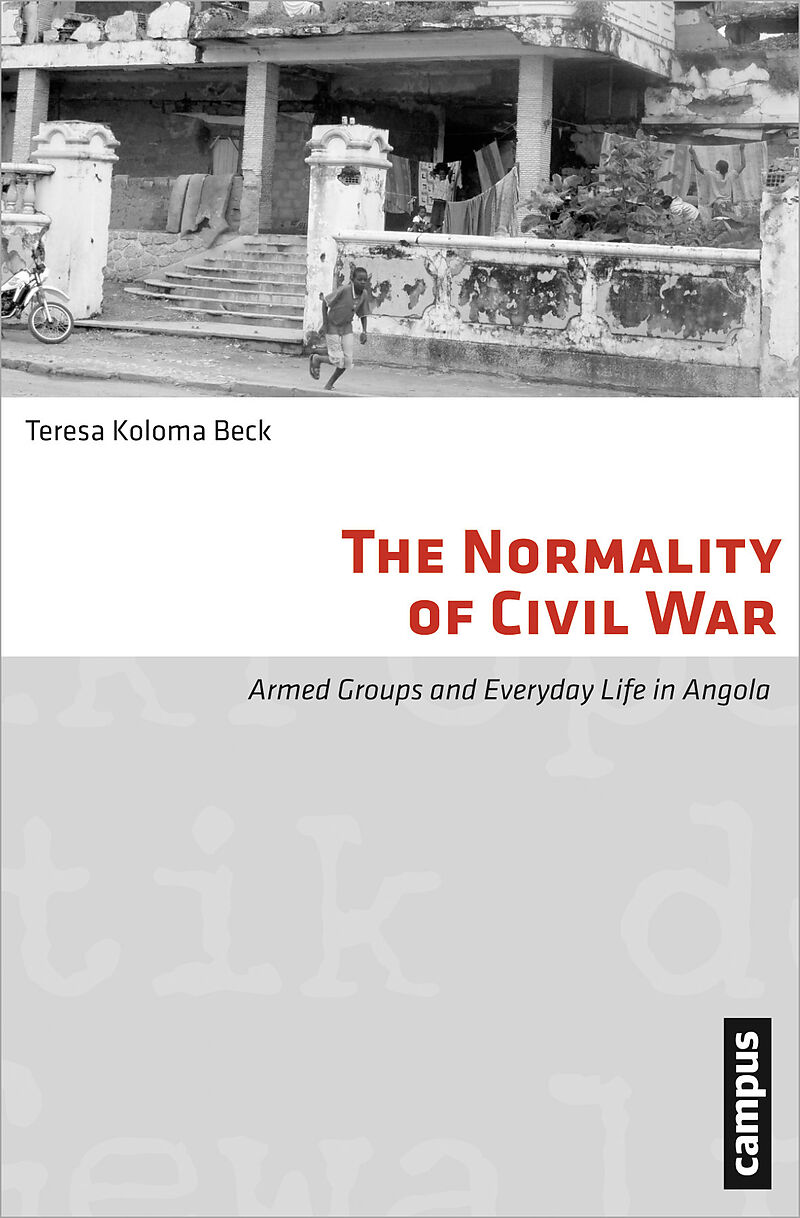The Normality of Civil War
Einband:
Kartonierter Einband
EAN:
9783593397566
Untertitel:
Armed Groups and Everyday Life in Angola
Genre:
Medien & Kommunikation
Autor:
Teresa Koloma Beck
Herausgeber:
Campus Verlag GmbH
Auflage:
1. Auflage
Anzahl Seiten:
162
Erscheinungsdatum:
2012
ISBN:
978-3-593-39756-6
Mikropolitik der Gewalt
Krieg gilt gemeinhin als Ausnahmezustand, den es zu überwinden gilt. Anhand der jüngeren Geschichte Angolas zeigt Teresa Koloma Beck, wie die Präsenz von Gewalt und Gewaltakteuren zur Herausbildung einer eigenen Normalität des Bürgerkriegs führen kann. Das Buch wirft nicht nur ein neues Licht auf soziale Dynamiken in Bürgerkriegen, sondern auch auf typische Probleme in Nachkriegsgesellschaften.
Autorentext
Teresa Koloma Beck, Dr. phil., forscht an der Willy Brandt School of Public Policy der Universität Erfurt.
Leseprobe
The conditions in the Central Highlands were very complex. Especially in the villages it happened, for example, that at night it knocked on the door of a father. And his son, who was fighting on the other side, stood there, asking for money. Money for medicine, money for food. 'Father, we are dying out there!' he would say. What would this man do in such a situation? Would he act as one from the other side? Or as a father? (Interview, 2005m) The sound of shooting, the flickering of muzzle flash, burning houses and vehicles, people fleeing from the scenes of violence, corpses left behind-such or similar are the images that come to our mind thinking about war. Popular as well as academic discourse have cultivated an image of war as a state of emergency, as a temporary deviation from the "normal" course of affairs, a deviation that is marked by destructive and disruptive forces. But civil wars are not fought in one day; many of them last several years, some decades. In Sudan and Chad, Sierra Leone and Liberia, Angola and Mozambique, in Peru, Columbia and Nicaragua, in the Palestinian areas of Israel and the Kurdish territories of Turkey and Iraq, in Lebanon, as well as in East-Timor, Myanmar and Vietnam violent conflicts have been going on for ten to thirty years. Given the time horizons of existential human activities such as cultivating fields or raising children, this seems to be a rather long period to be experienced as a transitory state of emergency. Moreover, as psychological research shows, a persistent experience of crisis quickly leads to a breakdown (Schauer, Elbert and Neuner, 2005). Therefore, a "state of emergency"-perspective on wars might be useful in the reconstruction of political and legal problems. Yet, its contribution to the understanding of the social processes in war situations can only be limited. This observation, however, raises a fundamental epistemological question: if not as a state of emergency, how can war situations otherwise be conceived? The aim of this book is to propose an answer to this question. In the spirit of qualitative empirical research, the discussion develops around a case study on civil war in Angola. The account cited at the beginning vividly illustrates the limitations of an state of emergency-perspective on violent conflict. Collected during field research in Angola, it describes a situation, which, according to the interviewee, was typical for the civil war period: a father finds himself in a dilemma to choose between, on the one hand, loyalty to the armed group that is ruling the area he lives in, and, on the other hand, loyalty to his combatant son who is "from the other side". The confrontation takes place at his very doorstep, and the decision he is confronted with affects him in a rather personal and emotional way. Fatherly loyalty would be the obvious choice; yet, it would also bring him into perilous conflict with the armed actors ruling the territory. The story shows how, in a civil war situation, the civilian and the combatant milieu come to meet in a contentious everyday life. Moreover, the wording of the interviewee suggests that, to his experience, the scene was all but exceptional. This story, thus, defies the notion of war as a state of emergency; moreover, it contradicts the commonly assumed distance between the realm of the combatants and the non-combatants. While putting common implicit presumptions about violent conflict into question, it also serves to reveal the very same presuppositions: in the common epistemology of war, the latter appears, firstly, as crisis suspending "normality". And secondly, it is assumed that this crisis is driven by a particular constellation of agents, by the violent confrontation between at least two armed groups, fighting at the expense of an innocuous civilian population. The distinction between those who are waging war and those who fall prey to it is supposed to be identifiable and clear cut as well as the distinction between the armed opponents themselves. Tacitly orienting research and analysis, these implicit presumptions have major implications for the study of wars in academia and beyond. Systematically, they draw the researcher's attention, on the one hand, to events indicative or emblematic for a state of emergency; and on the other, to the protagonists of war situations: armies and armed groups. Invariably, the warring parties and the so-called civilian population appear as mutually exclusive and intrinsically contradicting spheres, touching each other but episodically, typically in moments of violence and destruction. The origins of these preconceptions can be found in the ideal of trinitarian warmaking, described by Carl von Clausewitz against the background of the state formation-wars in Western Europe (Clausewitz, 2008; see also van Creveld, 1991, 35-41). They are, hence, closely linked to the project of modernity that cultivates an image of society as being peaceful and progressive, and therefore can conceive of war only as of an exceptional event, limited in time and space (Bauman, 1993, 1-30; Spreen, 2008, 30-4; Reemtsma, 2012). Yet, the idea of war taking place contained and controlled at the outside of society never captured its social reality. The combatants themselves are always commuters between the realm of battle and the realm of civilian life, bringing war back home, but also bringing elements of "home" to the front. In war "civilian" and "combatant" life are, thus, intimately related, conditioning and informing each other constantly. For the study of contemporary conflict, acknowledging this interdependency becomes crucial. Since the end of World War II the majority of violent conflicts around the globe have been intra-state wars (Schreiber, 2001). The latter systematically abrogate the boundaries separating the realm of combat from the realm of civilian life. In doing so, they introduce an expansion of war into the sphere of everyday life. This observation serves as a starting point for the endeavour undertaken in this book, i.e. to conceive war beyond alleged notions of emergency. 1.1 The problem: the expansion of civil war into everyday life Commonly, violent conflicts within states are called "civil wars". This terminology emphasises that conflict takes place between people, who belong to the same political entity, who are citizens of the same state. In military strategy, such wars have also been called "low intensity conflicts" to highlight that they are fought for longer periods of time, but with low intensity and frequently in the absence of advanced weapon systems (van Creveld, 1991, 42-52). Looking, however, beyond political and strategic concerns at the social dynamics of such conflicts, their most salient feature consists in their tendency to negate the distinctions considered to be constitutive for inter-state wars. First and foremost, civil wars blur the boundary between combatants and non-combatants. The reason thereof is plain: the protagonists of intra-state conflicts, beside the state itself, are non-state armed groups. Different from regular armies that institutionally and especially financially are backed by the state, armed groups have to rely on the so-called civilian population in order to sustain their ranks and to provide for sufficient supplies. This has far reaching consequences: in the perspective of the oppone…

Leider konnten wir für diesen Artikel keine Preise ermitteln ...
billigbuch.ch sucht jetzt für Sie die besten Angebote ...
Die aktuellen Verkaufspreise von 6 Onlineshops werden in Realtime abgefragt.
Sie können das gewünschte Produkt anschliessend direkt beim Anbieter Ihrer Wahl bestellen.
Loading...
Die aktuellen Verkaufspreise von 6 Onlineshops werden in Realtime abgefragt.
Sie können das gewünschte Produkt anschliessend direkt beim Anbieter Ihrer Wahl bestellen.
| # | Onlineshop | Preis CHF | Versand CHF | Total CHF | ||
|---|---|---|---|---|---|---|
| 1 | Seller | 0.00 | 0.00 | 0.00 |
